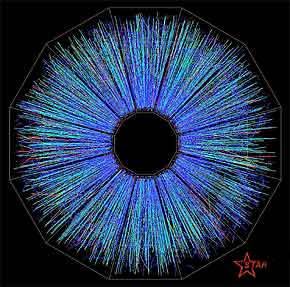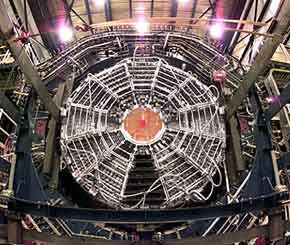At 9 p.m. EDT, on June 12, scientists at the
Brookhaven National Laboratory recorded the first head-on collisions
between the nuclei of gold atoms inside the Relativistic Heavy Ion
Collider (RHIC), the newest and largest particle collider ever built for
nuclear physics studies. The collisions at RHIC were recorded on a huge
detector called STAR (Solenoidal Tracker At RHIC), the heart of which was
a Time Projection Chamber (TPC) which was designed and built by engineers,
technicians, and researchers here at Berkeley Lab.
 |

VIEW OF A PARTICLES STREAMING OUT FROM A HEAD-ON COLLISION
BETWEEN GOLD NUCLEI, AS SEEN BY THE STAR DETECTOR
|
"We are crossing into a new frontier of scientific inquiry,"
said Energy Secretary Bill Richardson. "Scientists from around the
world will use this facility to answer some of the most basic questions
about the properties of matter and the evolution of our universe."
Berkeley Lab Director Charles Shank said the milestone represents
another success in the impressive legacy of contributions this Laboratory
and its scientists have made to nuclear science research. "We are
proud to be an active participant in this international
collaboration," he said. "This achievement signals the beginning
of an exciting new period of nuclear exploration and discovery."
RHIC is actually two giant accelerator rings, each 3.8 kilometers (2.4
miles) in circumference and containing more than 1,700 superconducting
magnets. These magnets steer gold nuclei -- gold atoms stripped of their
electrons -- in tight beams around the rings at near-light speed until
they have been accelerated to energies as high as 100 billion electron
volts (100 GeV) per nucleon.
Upon reaching peak energies, the dual beams of gold nuclei are stored
in the rings and forced to cross paths at six different intersections.
This subatomic demolition derby yields thousands of collisions every
second at 10 times the energy reached in the heavy ion experiments at
CERN, the international high-energy laboratory near Geneva, Switzerland.
The temperature of the nuclear matter in these collisions at RHIC is
expected to approach one trillion degrees above absolute zero, hot enough
to "melt" the gold nuclei into their constituent quarks and
gluons and allow these normally bound particles to briefly exist free of
one another in a soup-like quark-gluon plasma.
A quark-gluon plasma is a state of matter believed to have last existed
a few millionths of a second after the Big Bang that created our universe.
Recreating this a primordial state of matter in RHIC and studying its
properties should help scientists explain the origins of protons and
neutrons, and other elementary particles, and learn how they managed to
combine to create the diverse forms of matter we see today. A better
understanding of quark-gluon plasma might also help explain why the
universe has its current structure.
Four experiments have initially been set up to capture and analyze the
results of the collisions at RHIC. One of the largest of these experiments
is STAR, which is designed to search for the telltale signatures of
quark-gluon plasma formation by simultaneously tracking and identifying
thousands of particles in the debris. STAR will also be used to
investigate the behavior of strongly interacting matter at high energy
density. The centerpiece of STAR is the TPC.
 |

THE TIME PROJECTION CHAMBER FORMS THE HEART OF THE STAR DETECTOR
|
Invented in 1974 by Berkeley Lab physicist and detector expert David
Nygren, TPCs are barrel-shaped, gas-filled detectors with sophisticated
electronics plastered on the end.
A TPC can clearly distinguish between similar types of particles by
translating the spatial position of their tracks into the time it takes
the signals to drift through a given distance in a gas. TPCs are unique in
that they can detect and sift through thousands of particles at once.
Construction of the $15 million TPC for STAR, which involved more than
20 Berkeley Lab scientists and engineers, was led by physicist Howard
Wieman of the Nuclear Science Division (NSD) and Russ Wells of the
Engineering Division (ED). Construction of the entire $60 million STAR
detection system was overseen by NSD physicist Jay Marx and ED Engineer
Bill Edwards.
Says Marx, "After so many years of hard work by so many people
it's thrilling to see the first pictures from STAR. Now comes the most
exciting part -- trying to understand what nature is telling us about how
nuclear matter behaves in the extreme conditions that existed only a few
millionth of a second after the Big Bang."
Construction of the STAR TPC was completed in 1997. After it passed all
commissioning tests with flying colors, the machine was transported to BNL
in November of 1998 via a C5A cargo plane. Some 400 scientists and
engineers, representing some 40 institutions here and abroad, will be
participating in the STAR experiment, which is led by former Berkeley Lab
physicist John Harris who is now at Yale University. Among these
participants will be Berkeley Lab physicist Hans-Georg Ritter, one of the
leading authorities on quark-gluon plasma.
Says Ritter about the recording of the first collisions at RHIC,
"It shows that this collider works and that STAR works beautifully.
We should be able to begin collecting data within the next few
weeks."
Additional Information:
|


